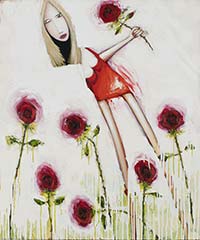
Dear rose, thy joy’s undimmed,
Thy cup is ruby-rimmed,
Thy cup’s heart nectar-brimmed. Robert Browning 1855
The aesthetic beauty of flowers has inspired poets and artists throughout the ages and especially the rose that was considered to be the queen of all flowers. Universally, the rose is the flower of love, symbolising the heart’s object of desire. It is this same sense of wonder at the rose’s ephemeral beauty and its mysterious allegorical connections that gave rise to Gordon Richards’ current body of work. The recent paintings and charcoal drawings express a somewhat more reflective side to usually exuberant Richards. They describe a quieter state of mind and doubtlessly bear the mark of his relocation, two years ago, from the frenetic buzz of inner city Sydney to the bird-trilled, cooler clime of the NSW Southern Highlands.
In the grounds of his new abode Richards discovered vestiges of a once grand rose garden. Ever the horticultural enthusiast, he forthwith set about restoring and adding to it with further rose species. Each morning, as a kind of meditation and a ‘means of exercise’, Richards starts the day with a few hours tending his profuse garden before entering the studio. He discloses that the new work and its title were inspired by the curious glow that appeared halo-like around his roses in the early morning light. “Those full blooms, heavy with dew, seem to smile at you,” says Richards. Later in afternoon sun, he and his partner Yvonne, a fellow-artist and his longtime muse, oft share a leisurely coffee break amid the many flowerbeds’ heady perfumes.
Richards’ universe is full of radiant energy. There is a sense of liberation and contentment that has the power to lift one from the cares of the mundane world. The potency of the garden imagery invites both reverie and introspection, for his is an iconography of hope and celebration of life’s abundance. The new paintings conjure a pleasure in observing the constantly changing spectacles of nature. Rows of roses take centre stage, each work referencing a particular hue: white might represent purity, innocence and humility; red, perhaps vitality, passion or courage; pink, gentleness and the charms of youth; yellow, gladness, warmth and sunny days.
The roses communicate the artist’s delight in everything beautiful. Richards’ recurring motif of the gorgeous blonde is again present, sometimes gleeful with arms outstretched, sometimes pensive in her colour-matched dress. Richards offers a play of the marvellous in radically simplifying her form to its essential lines. She and the delicate rose blooms are the embodiment of grace and loveliness. However, Richards is aware that this fragile flower protected with thorns also connotes the transient nature of all earthly beauty. Paint drips and dribbles down from the full-blown blooms nodding in their own heady scent, like trickling dew, or time, that will ultimately dissolve their sumptuous colours.
Richards communicates a genuine, experienced ‘joie de vivre’. We want to participate in the exuberance with which he embraces life and all that makes it worth living. Quite apart from any narrative content, this is expressed in tactile, sensuous surfaces. There is no semblance of restraint or deliberation to his approach, the paintings seem a declaration of personal freedom. We are ever charmed by his optimistic enthusiasm – his vision of interconnectivity, his seeing for being rather than seeing for knowing. Gordon Richards might well describe his artmaking with the words of Henri Matisse, “I am unable to distinguish between the feeling I have about life and my way of translating it.”
Receive e-mail updates on our exhibitions, events and more
Subscribe Now